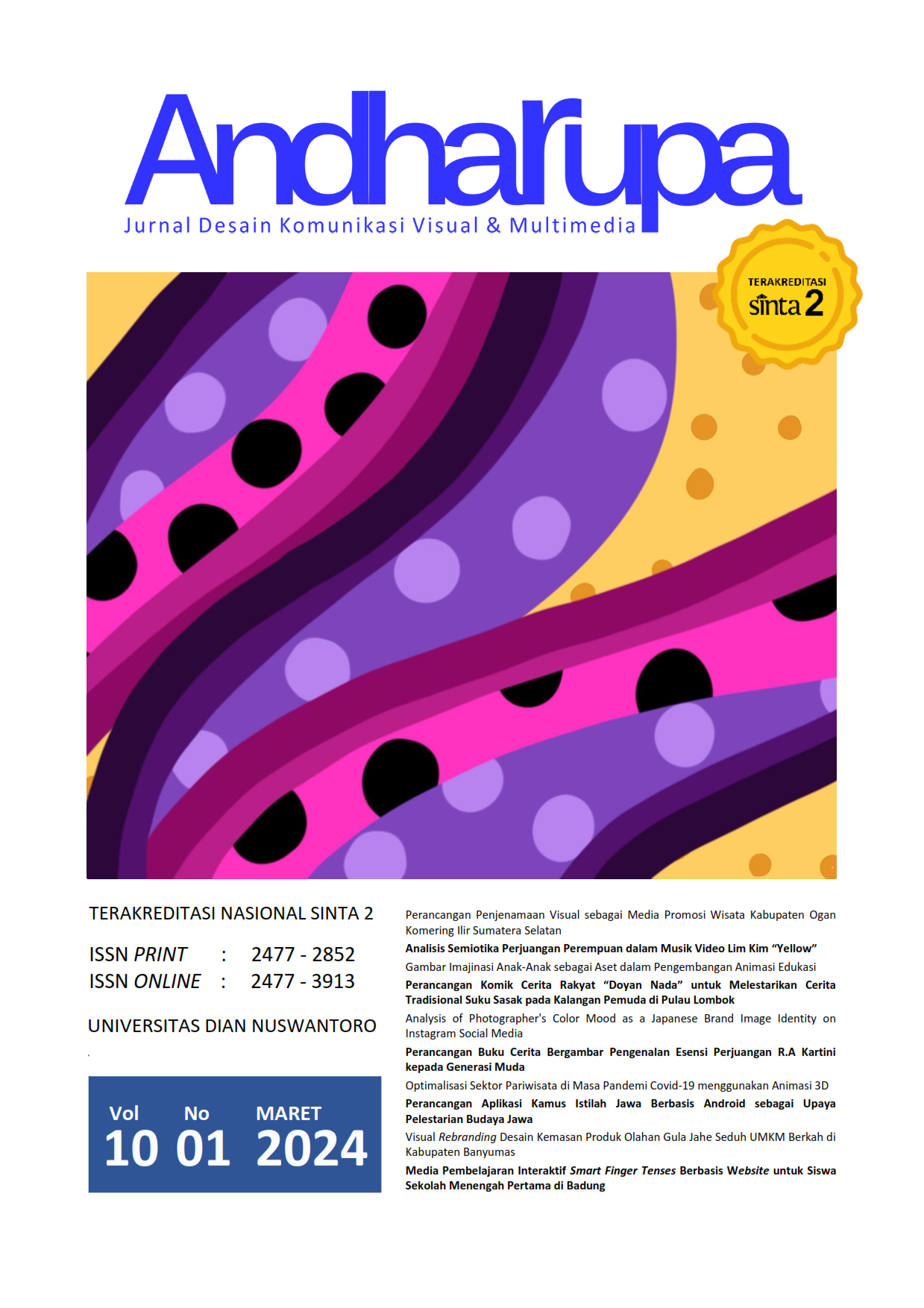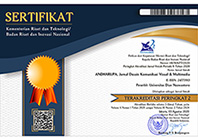REPRESENTASI SOSIO-KULTURAL MASYARAKAT BUDAYA AREK DALAM BONEKA WAYANG GATHOTKACA KRODHA PADA WAYANG JEKDONG
DOI:
https://doi.org/10.33633/andharupa.v10i01.8040Abstract
AbstrakSeni wayang kulit Jekdong adalah warisan budaya komunitas budaya Arek yang telah berkembang sesuai dengan dinamika dan karakter budaya Arek. Boneka wayang kulit Jekdong memiliki fitur khas yang membedakan jenis wayang kulit lainnya di Pulau Jawa. Keunikan bentuk ini tidak lain adalah cerminan dari nilai-nilai lokal budaya Arek. Boneka tokoh Gathutkaca Krodha dianggap salah satu tokoh yang paling sesuai untuk mewakili seni wayang Jekdong. Gathutkaca Krodha adalah sosok yang populer karena intensitasnya yang sering ditampilkan dalam berbagai pertunjukan boneka Jekdong. Tujuan penelitian ini adalah untuk menelisik lebih dalam cara-cara masyarakat budaya Arek mencerminkan karakter budaya yang dimilikinya pada wujud visual boneka wayang Jekdong. Penelitian ini berfokus pada rupa visual boneka wayang Gathutkaca Krodha yang dianalisis berdasarkan komponen sindrom atau ciri-ciri rupa boneka wayang Jekdong dan didukung oleh teori semiotika Pierce dan Barthes dalam penelusuran pemaknaannya. Hasil penelitian menunjukkan bahwa penampilan wayang Gathutkaca Krodha mencerminkan karakteristik budaya agraris-pesisir rakyat jelata dengan menampilkan instrumen alat pertanian dan kecenderungan untuk mendekati bentuk kelugasan visual realis-naturalistik untuk mengkomunikasikan karakater sosok Gathutkaca. Kata Kunci: Arek, Gathutkaca Krodha, semiotika, wayang Jekdong AbstractJekdong Leather Puppet Art is a cultural heritage of the Arek cultural community that has developed in accordance with the dynamics and character of the Arek culture. Jekdong wayang kulit puppets have distinctive features that make distinctions from other types of wayang kulit on the island of Java. The peculiarities of this form of form are nothing but a reflection of local values of Arek culture. Gathutkaca Krodha's puppet figure is considered one of the most suitable figures to represent the Jekdong puppet art. Gathutkaca Krodha is a popular figure because of its intensity which is often shown in various Jekdong puppet shows. The purpose of this study is to explore more deeply the ways in which the Arek cultural community reflects the cultural character it has in the visual form of the Jekdong puppet. This study was analyzed by identifying the visual form based on the components of the syndrome or the visual characteristics of Jekdong puppet puppets, and supported by the theory of semiotics in the search for meaning. The results of the study show that the appearance of the Gathutkaca Krodha puppet puppet reflects the characteristics of the agrarian culture of the common people by displaying agricultural tool instruments and the tendencies to approach realis-naturalistic visual form to communicate the Gathutkaca figure. Keywords: Arek, Gathutkaca Krodha, Jekdong puppet doll, semioticReferences
Ansori, Y., & Kusrianto, A. (2011). Keeksotisan Batik Jawa Timur. Elek Media Komputindo.
Carey, P. (2016). TAKDIR : Riwayat Pangeran Diponegoro (1785-1855) (4th ed.). Kompas.
Christianto, W. N. (2012). NYALAP-NYAUR: MODEL TATAKELOLA PERGELARAN WAYANG JEKDONG DALAM HAJATAN TRADISI JAWATIMURAN. Humaniora, 24(2), 175–186.
DeVries, K., Smith Robert Douglas, & Smith Kay Douglas. (2007). Medieval Weapons An Illustrated History of Their Impact. ABC-CLIO.
Hasanudin. (2001). Batik pesisiran : melacak pengaruh etos dagang santri pada ragam hias batik. Kiblat Buku Utama.
Hogarth, B. (2003). Dynamic Anatomy: Revised and Expanded Edition (1st ed.). Watson-Guptill Publications.
Holt, C. (2000). Melacak Jejak Perkembangan Seni di Indonesia. Arti Line.
Hoop, V. der. (1949). Ragam-ragam Perhiasan Indonesia. Koninklijk Bataviaasch Genootschap Van Kunsten en Wetenschappen.
Kartika, D. S. (2007). Budaya Nusantara : Kajian Konsep Mandala dan Konsep Triloka/Buana terhadap Pohon Hayat pada Bati Klasik. Rekayasa Sains.
Kartika, D. S., & Perwira, N. G. (2004). Pengantar Estetika. Rekayasa Sains.
Kayam, U. (2001). Kelir Tanpa Batas. Gama Media untuk Pusat Studi Kebudayaan (PSK) UGM, dengan bantuan The Toyota Foundation.
Koentjaraningrat. (2015). Pengantar Ilmu Antropologi. Rineka Cipta.
Lombart, D. (2018). Nusa Jawa Silang Budaya 3: Warisan Kerajaan-Kerajaan Konsentris. Gramedia Pustaka Utama.
Magnis-Suseno, F. (1993). Etika Jawa Sebuah Analisis Falsafi Tentang Kebijaksanaan Hidup Jawa (5th ed.). Gramedia Pustaka Utama .
Mattesi, M. (2008). Force: Character Design from Life Drawing: Character Design from Life Drawing (Force Drawing Series). Routledge.
Millidge, G. S. (2009). Comic Book Design. Watson-Guptill Publications.
Noerhadi, I. C. (2012). Busana Jawa Kuna. Komunitas Bambu.
Noth, W. (1990). Handbook of Semiotics. Indiana University Press.
Raffles, T. (2016). The History of Java. Narasi.
Solarski, C. (2012). Drawing Basics and Video Game Art Classic to Cutting-Edge Art Techniques for Winning Video Game Design. Clarkson Potter/Ten Speed.
Sumardjo, J. (2014). Estetika Paradoks. Kelir.
Surwedi. (2014). Jaman Antaraboga Layang Kandha Kelir. Buku Litera.
Timoer, S. (1988). Serat Wewaton Pedhalangan Jawi Wetanan: Jilid I. Balai Pustaka.
Winter Sr, C. F., & Ranggawarsito, R. Ng. (2007). Kamus Kawi-Jawa. Gadjah Mada University Press.
Downloads
Published
Issue
Section
License
Copyright (c) 2024 ANDHARUPA: Jurnal Desain Komunikasi Visual & Multimedia

This work is licensed under a Creative Commons Attribution 4.0 International License.
Authors who publish with this journal agree to the following terms:
- Authors retain copyright and grant the journal right of first publication with the work simultaneously licensed under a Creative Commons Attribution License that allows others to share the work with an acknowledgment of the work's authorship and initial publication in this journal.
- Authors are able to enter into separate, additional contractual arrangements for the non-exclusive distribution of the journal's published version of the work (e.g., post it to an institutional repository or publish it in a book), with an acknowledgment of its initial publication in this journal.
- Authors are permitted and encouraged to post their work online (e.g., in institutional repositories or on their website) prior to and during the submission process, as it can lead to productive exchanges, as well as earlier and greater citation of published work (See The Effect of Open Access).















